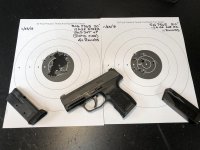When I'm in the market for a new gun, those articles/ videos can give an idea which guns I might consider looking at (there are so many) in the first place. That is if they are well done and the distances are appropriate, i.e. 25 or 50 yards.
They don't, though. They're conducted with one gun, with one batch of ammo. In other words, it would be like if I went into a truckload of ammo, plucked a single cartridge from one box, chronographed it, and declared whatever number I got to be the average velocity for the entire truckload.
Is it? Maybe. But the confidence factor--how reliable the statistic is--is very low.
To put it in other terms, suppose I tested a single Remmy 700, and got a .5-inch average group. It would be fair to say that
that particular Remmy shot pretty good. It would not be fair to say that
every single 700 shot that well, or that buying a $1900 Christiansen Arms Ridgeback was a waste since it only shoots as well as a $400 Remington. Or, for that matter, that you should expect that kind of performance with factory ammo out of whatever Remington you wound up with. You might very well get that, or you might not.
The magazine accuracy test also ignores one very conspicuous phenomenon. Frequently, they're conducted with pre-production or very early production examples (and sometimes, cherry-picked units). Some manufacturers are
infamous for having very high quality and low initial production, but as soon as they realize they've got a winner, ramping up production big-time and sacrificing some quality along the way.
Take, for example, the Ruger Precision Rifle. Initial testing numbers and early buyers' reports were absolutely absurd--groups ranging from .15" to .3" were incredibly common. Buying an RPR was a no-brainer. Now that Ruger has increased production to meet the demand generated by those absurd numbers, not many people are seeing .3" guns. Frankly, for the price, they're still getting a good deal--great ergonomics and a sub-MOA rifle for under a grand--but later, high-volume examples just aren't as impressive as the early rifles.
LVSteve said:
The Rifleman tests involve three or more types of ammo, each contributing five strings of five rounds.
Yes, I have read gun magazines before. Same thing--one gun, one lot of ammo. That they tried three brands is not significant, aside from weeding out a particular brand or bullet weight that that gun didn't like, and giving you a better idea of what the individual example in question is capable of.
Their gun tells you nothing about
your gun, or the gun you're thinking about buying.
Beauetienne said:
Amen. Why wouldn't someone want to know the potential of their firearm?
Then test yours.
And protip--what the gun is capable of is irrelevant. It's about what
you and the gun are capable of that matters. Reading about what some fool in a magazine shot doesn't tell you much about your situation.

